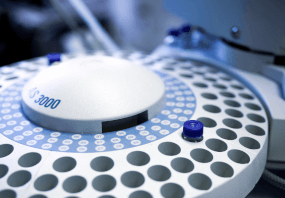General description
2-Acetylamino-3-[4-(2-acetylamino-2-carboxy-ethylsulfanylthiocarbonylamino)phenylthiocarbamoylsulfanyl]propionic acid (2-AAPA) can block reductase systems, thereby modulating peroxiredoxin oxidation and mitochondrial function in A172 glioblastoma cells.
Biochem/physiol Actions
Abnormal thiol redox state (TRS) is involved in the pathogenesis of a variety of diseases, such as chronic heart disease and atherosclerosis, rheumatoid arthritis , AIDS , Parkinson disease, Alzheimer disease, etc. Thus there is a need for tools capable of regulating TRS. Glutathione reductase (GR) is a critical enzyme in the homeostasis of TRS. Thus selective GR inhibitor would be a valuable research tool in studying TRS-related processes. Carmustine (#C0400) an anticancer drug is commonly used as GR inhibitor (IC50~470 microM). 2-AAPA is novel, potent cell-penetrable GR inhibitor. The compound is quite selective. But small reduction of activity for GP and GST was observed at 0.1mM concentration of 2-AAPT.
Glutathione reductase (GR) is a critical enzyme in the homeostasis of cellular thiol redox state. 2-AAPA is potent, selective, cell-permeable GR inhibitor, a valuable research tool in studying processes related to thiol redox state. For example, it was used in a study of the relationship between thiol redox state and overall redox state. In addition to the expected decrease in GSH and increase in GSSG, 2-AAPA increased the ratios of NAD(P)H/NAD(P)+. Significant protein glutathionylation was also observed.
Molecular Weight: 518.65. Empirical Formula: C18H22N4O6S4 . Quality Level: 100. Assay: ≥. 95% (HPLC). form: powder. solubility: DMSO: 10 . mg/mL, clear. storage temp.: 2-8°C. Storage Class Code: 11 - Combustible Solids. WGK: nwg. Flash Point(F): Not applicable. Flash Point(C): Not applicable.- UPC:
- 51182219
- Condition:
- New
- Availability:
- 3-5 Days
- Weight:
- 1.00 Ounces
- HazmatClass:
- No
- MPN:
- A4111-25MG












